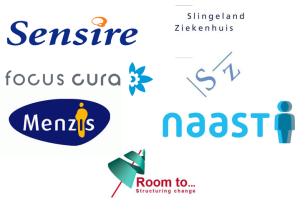COPD InBeeld
Nearly 600.000 people in the Netherlands suffer from COPD. The treatment of patients with COPD is primarily focused on preventing and reducing lung exacerbations. Lung exacerbations often lead to (re)admission to the hospital and ensure worsening of the lung function. Almost 20% of the total annual costs for the treatment of COPD patients are due to hospitalization
At the Slingeland Hospital & Sensire the project COPD InBeeld has started to improve the quality of life of people with COPD, among others, by stimulating the self-management of patients. Lung exacerbations worsen the quality of life and cause deterioration. If patients recognize the signs earlier, lung exacerbations and readmissions can be prevented.
Via COPD InBeeld, chronic lung patients are remotely monitored by the hospital and the home care organization Sensire. This is made possible by means of e-health apps from care innovation company FocusCura. The new care pathway is patient-centered and fully designed with doctors, nurses and patients. It works as following: Patients are included in the InBeeld program in the hospital. Patients complete a digital questionnaire at home twice a week, which is aimed at measuring the perceived health condition of patients. Patients send their values twice a week via the app cVitals from FocusCura. Each patient has its own customized norm value. Since each patient has a different stage of the disease. The outcomes of the checklist are then matched with the personal norm values of the patient. When the outcomes deviate from the norm values, red flags appear in the system. Nurse specialists from the Medical Service Center NAAST have insight in the outcomes of the checklists, they check whether patients fill in the checklist, what the outcomes are and which red flags to follow up on. The nurses contact patients with red flags via video consultation. Patients are also able to contact the medical service center NAAST 24/7 hrs a day via video consultation when they are worried about their health. If there is indeed an increased risk or if the patient has any questions, Sensire’s (homecare organization) specialized lung nurse will contact the patient to prevent any deterioration of the situation. If necessary, when more specific expertise is necessary, for example a medication change is needed, the nursing practitioner or pulmonologist from the Slingeland Hospital can have contact with the patient. In this way, patients no longer have to wait for hospital consultation hours before they are helped and there are no “routine” consultations at the hospitals when not strictly necessary. If the nurse practitioner finds it necessary though, the patient will still visit the hospital, but then almost immediately at a specific exacerbation consultation (prioritized consulting). By immediately intervening, the number of visits by patients to the emergency department and the number of hospital admissions decreases. Before the inclusion in COPD InBeeld, patients had an average of 0,59 annual visits at the emergency department. After inclusion this number has dropped to an average of 0,44 visits per year (N=33). Besides, the average number of clinical nursing days of COPD patients decreased from 5,11 days annually before inclusion to 3,69 days after inclusion (N=33).
At this moment ca 100 patients are participating in the process. On average, ten patients per day have visual contact with the nursing staff at the medical service center NAAST and three to four with the nursing specialist at Slingeland Hospital. Patients indicate that they experience InBeeld as very pleasant. They feel more independent, more confident and safer through remote monitoring.
In total there are almost 1,200 COPD patients under treatment at Slingeland Hospital, of which about 350 patients are eligible to participate in COPD InBeeld. It involves patients at risk of lung exacerbations, who can work with a tablet and speak Dutch.

